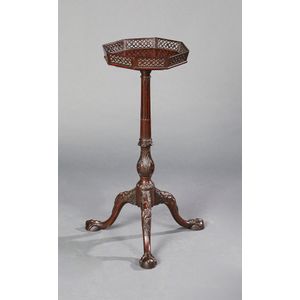George III Mahogany Torchere Stand
You must be a subscriber, and be logged in to view price and dealer details.
Subscribe Now to view actual auction price for this item
When you subscribe, you have the option of setting the currency in which to display prices to $Au, $US, $NZ or Stg.
- Pierced Decoration - Ornamental woodwork with part of the background cut through and removed to produce an open-work pattern.
- George Iii - George III (1738 - 1820) was King of Great Britain and Ireland from 1760 to 1820.
- Acanthus - A stylized leaf motif, one of the primary decorative elements of classical Greek and Roman architecture, derived from the genus of flowering plants in the family Acanthaceae, native to tropical and subtropical regions of the Mediterranean area. It is a common element in classical Greek and Roman design, and is often seen in Corinthian and Composite order columns and used as a decorative element in English, European and Australian furniture, particularly on the curve of a leg, and as decoration for a corbel.
- Fretwork - Pierced intricate decorative patterns, cut with a fine saw and generally found around the galleries of desk tops, open-hanging shelves and small tables.
In open fret, the timber is completely pierced, giving an appearance of great lightness and delicacy.
With blind fret, as seen in Chinoiserie styles of Chippendale, the fretwork is applied like a moulding to a solid panel. - Column - An architectural feature sometimes used for decorative effect and sometimes as part of the supporting construction. Columns should generally taper slightly towards the top. They may be plain or decorated with carving, fluting or reeding. Columns may be fully rounded or, more commonly, half-rounded and attached with glue, screws or pins to the outer stiles of doors, or the facing uprights on cabinets and bureaux.
- Mahogany - Mahogany is a dense, close grained red-coloured timber from the West Indies and Central America. It was first imported into Europe in the the early 18th century and its use continued through the 19th century. It was popular for furniture making because of its strength, the wide boards available, the distinctive grain on some boards, termed flame mahogany and the rich warm colour of the timber when it was polished.. The "flame" was produced where a limb grew out from the trunk of the tree, and this timber was usually sliced into veneers for feature panels on doors, backs and cornices.
Some terms used to describe mahogany relate to the country from which it originally came, such as "Cuban" mahogany, "Honduras" mahogany etc. However unless the wood has been tested the names assigned are more a selling feature, rather than a true indication of the timber's origin. - Fluting - A form of decoration found on many pieces of furniture, as well as ceramics, silver and clocks, in which round-bottomed grooves, of varying width and depth, are let into columns, pilasters, legs. As a general rule, flutes are cut in the vertical, though they may follow a turned leg in a spiral pattern. In cross-section, they may be described as a series of 'U' shapes, rising and narrowing at each end of the groove. Fluting is the opposite of reeding, with which fluting is often associated.
- Gallery - On furniture, a gallery is a small upright section, frequently pierced and decorated, around the tops of small items of furniture, such as davenports, side tables, and so forth. Galleries are made in brass or bronze,and be fretted, pierced or solid timber. A three-quarter gallery is one that surrounds three of the four sides of a table, desk or other top.
- Cabriole Leg - The cabriole leg evolved from an elongated scroll, curving out at the knee which may or may not be carved, and forming a serpentine shape as it descends to the foot.
First introduced into English furniture in the late 17th century, cabriole legs were widely used during the Queen Anne and early Georgian periods, where they frequently terminated in a pad foot or ball and claw foot. The style has had many imitators since then. The cabriole leg was re-introduced in the mid-19th century, and is commonly associated with the balloon-back dining or drawing-room chairs made in walnut, mahogany or, in Australia, cedar. The Victorian cabriole leg, on the whole, was rather more slender than the earlier form, following the French style, which emphasized the delicacy and daintiness of the chairs they were designed to support. Cabriole legs are sometimes found on windsor chairs, especially those made during the 18th century. - Baluster (furniture) - An architectural term for a column in a balustrade or staircase, often defined as a "vase shape". The shape is extensively used in furniture and decorative arts.
In furniture, it is used to describe a chair or table leg turned in that form, or more usually as an inverted baluster, with the bulbous section to the top. Less commonly used to describe a chair back that has the outline of a baluster. A baluster may also be split and applied to the front of a cupboard for ornamentation.
For ceramics and silver items it is often used to describe the shape of the whole item, rather than a part.
In Georgian glassware, the shape is commonly seen in the stem of glasses.
This item has been included into following indexes:
Visually similar items

An oak wine table, English, early 19th century, 66 cm high. Provenance: The Estate of the Late Annie Coogan

A Georgian oak tilt-top circular country wine table, the plain three plank top on slender baluster column support with tripod base and pad feet. good colour and patina. Diameter 67 cm, height 72 cm

An English circular oak wine table, early 19th century. 70 cm high, 56 cm diameter

A Georgian elm tilt top wine table with padfoot tripod base. Height 69 cm. Diameter 66 cm
